Key Points of This Article:
1. As the human-pet relationship deepens, cute pets have become a universal element in brand marketing—McDonald's Cat Nest sold out on launch, and Pizza Hut's "Pet Tunnel Bed" is highly sought-after by pet owners.
2. Cats and dogs in real life are irresistible, and their online virtual counterparts are equally adored—popular cute pet IP Line Friends' dog has become the target of brand collaborations this year.
3. "Cloud" pet adoption becomes a new trend. Nanjing Hongshan Zoo gradually gains popularity, and animal co-branding, "adoptive care of animals," becomes an important means for brands to narrate their ESG stories.
4. Small animals can provide a tangible form of emotional value, as well as a universally recognized symbol of spirit. Amid the overload of negative emotions today, they can quickly bridge the gap between brands and consumers, establishing an emotional resonance.
The lives of modern city dwellers have changed dramatically from the past, and correspondingly, so has the relationship between people and their pets. More and more people are projecting their emotions onto pets, which have transformed from "house-guarding tools" to "companions." According to Moojing Market Intelligence, from January to October 2023, the volume of pet-related content on mainstream social media reached 14.547 million mentions, with interactions exceeding 3.36 billion. ¶ From the massive popularity of Line Friends' dogs to the increasingly pervasive catchphrase "Hakimi, Hakimi," this year has undoubtedly been a breakout year for the "pet economy." Data from Quest Mobile shows that as of August 2023, the number of people interested in pets on the internet reached 323 million, a large user base that has allowed capital investors to see the potential in the pet economy. As of September, there have been 20 financing events in the pet industry within China, with investments of 100 million or more making up more than half, totaling over 1.2 billion yuan.
Not just investors, but brands are optimistic about the pet economy; many brands have chosen pet marketing as a way to win consumer favor, with varying focuses in their methods. At a time when the human-pet relationship is deepening, how can brands create hit products through pet elements? Why are adorable and dopey animals so irresistible? From pets to animals, how can brand marketing capture people's hearts and convey value? We will review this in detail in this article.
As pets become "partners" and even family members to humans, brands have begun to target cats and dogs for marketing.
From November 15 to 19, McDonald's launched a limited-time "Meow Double Meal" for 99 yuan. Customers who purchased this meal set received a limited edition Cat Nest. The Cat Nest continued McDonald's classic packaging colors, and the official statement was that the design inspiration came from the scenario where cats play with the takeaway bags of McChicken at home, leading to the creation of the unique McDonald's-style Cat Pack.
Although many McDonald's followers said the meal set was priced higher than expected, the truth is in the physical response: within less than a minute of its launch, 100,000 meal sets were sold out. The adorable and practical Cat Pack captured the hearts of many pet owners, who shared their spoils online, with more than 10,000 related notes on the Xiaohongshu platform so far.
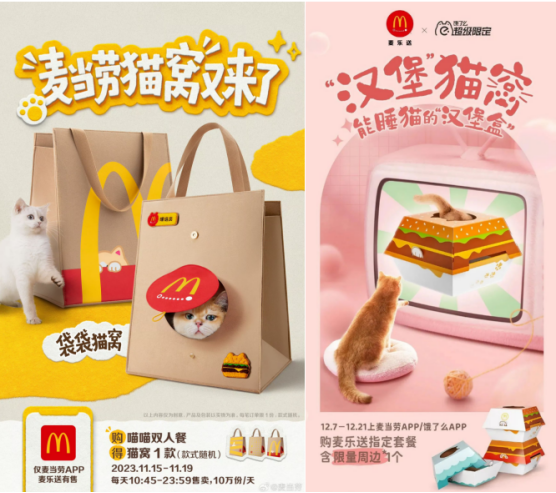
As early as 2021, McDonald's had launched the "Burger Cat Nest," which sold out its 100,000 limited edition sets within half a day, similar in popularity to this year. According to Moojing Market Intelligence, the interaction volume for the "Burger Cat Nest" entry surged to 79,000 in December 2021, causing a phenomenal discussion on social media, with pet owners eager to provide their feline overlords with a cute and sleep-friendly burger box.
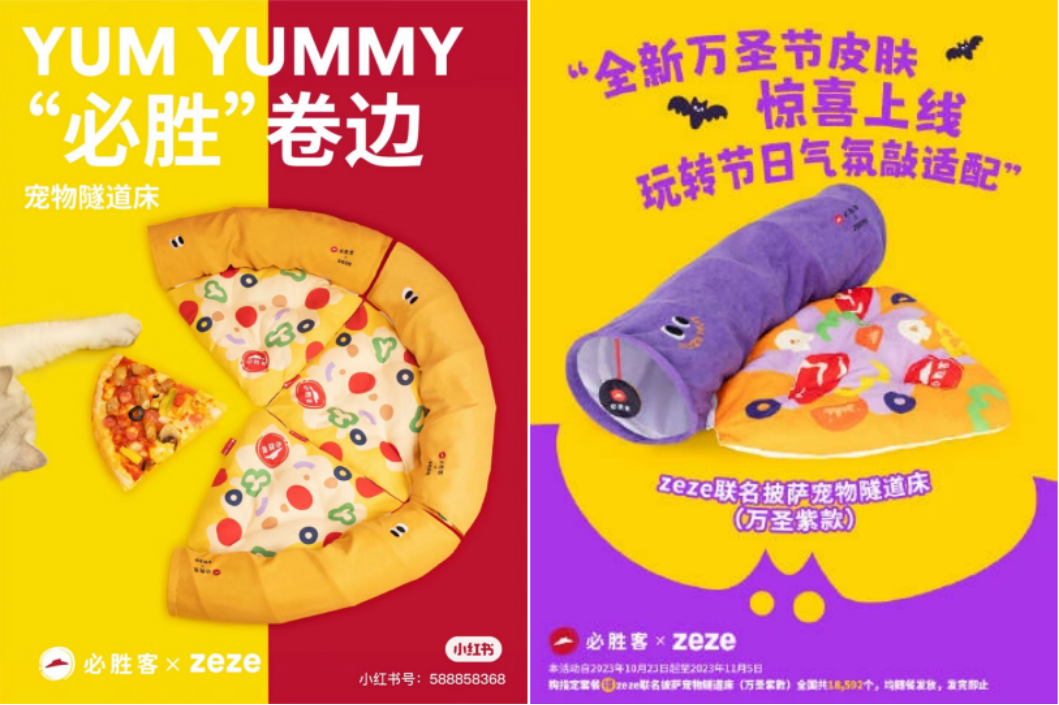
McDonald's isn't the only brand to launch a Cat Nest this year. In August, Pizza Hut and the pet supplies brand Zeze co-launched the Pizza Hut roll-edge "Pet Tunnel Bed," which was given away with the purchase of a designated meal set. The Pet Tunnel Bed is highly playable, with little toys at both entrances to attract cats to go in and out, and they can rest on the colorful pads when tired. Near Halloween, the brand also launched a special holiday edition.
This peripheral was extremely popular, with many netizens complaining it was impossible to grab, and it was even scalped to around 300 yuan on the second-hand market. This co-branding event caused widespread discussion on mainstream social media, and according to Moojing Market Intelligence, the interaction volume for "Pizza Hut×Zeze" reached 227,000 from August to October 2023 ¶ In addition to these, KFC also launched pet toy peripherals through co-branding with Weika and Pop Pop Laboratory this year. As the relationship between people and their pets becomes increasingly close, cute pets seem to have become an omnipotent element in brand marketing. When event planning and product design are heartfelt and creative, they can achieve a synergistic effect greater than the sum of their parts.
Cats and dogs in real life are irresistible, and their online virtual images are equally adored. If a vote were held for the most popular IP image on the internet in 2023, Line Friends' dog would definitely be nominated.
Moojing Market Intelligence data shows that from January to October 2023, Line Friends' dog had a mention volume of 237,000 on mainstream social media, a 1750.7% increase from the previous quarter, with related interactions reaching 58.489 million. During this year's Double 11 shopping event, Line Friends' dog broke into the top 10 for licensed product sales in the first four hours. Apart from self-licensed products, co-branded products across multiple categories became a focal point for consumer purchases.
As one of the top viral expressions, Line Friends' dog was created by Korean illustrator Moonlab Studio; the white one is a Maltese, and the brown one is a Golden Retriever. These two dogs often appear together, frolicking and playing, cute and with a strong sense of a couple, which created a space for imagination in subsequent co-branding activities.
This year's Valentine's Day collaboration with Luckin Coffee, the "Patch Dog Love Story," leveraged the two dogs couple concept lead to its first marketing circle breakout. During the event, limited edition drinks were launched, and purchases came with co-branded stickers, cup sleeves, and paper bags. Due to its overwhelming popularity, the stickers quickly sold out, eventually leading to an official "apology."
What's surprising is that some skilled netizens used the ordinary paper bags and cup sleeves to DIY standing cards and phone cases, enhancing user participation. By Qixi Festival, Luckin Coffee continued the co-branding event with Line Friends' dog and launched a "Patch Dog Love Privilege Card" to enrich the gameplay. The card designs were very cute, resulting in many netizens eagerly placing orders.
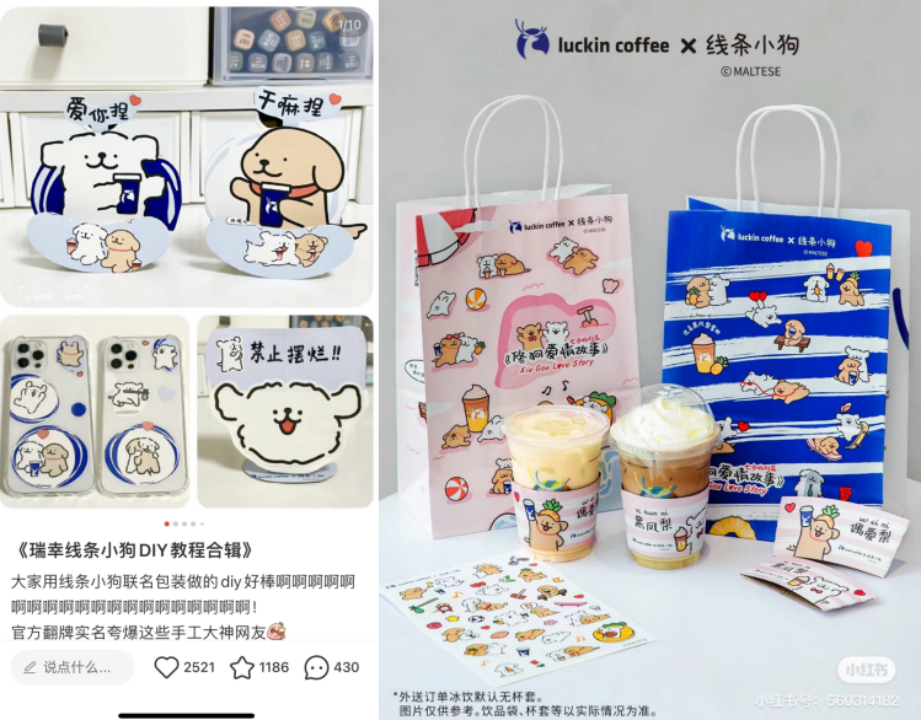
The popularity of this collaboration with Luckin Coffee was evident to all, and subsequently, many other brands also offered olive branches to the adorable Patch Dogs. Line Friends' dog subsequently co-launched products with Bai Que She, Curel, Ledeen, Little Odin, Labi Poem, Besies, and many other brands across multiple categories. These products caused widespread discussion on social media, and also performed well in terms of sales
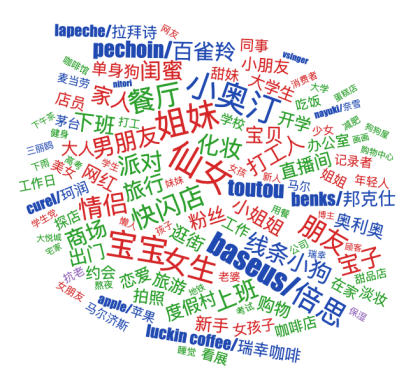
Taking Little Odin as an example, according to Moojing Analysis+ data, the brand's overall sales on mainstream e-commerce platforms from September to October 2023 were 57.984 million yuan, while sales of co-branded products with Line Friends' dog reached 12.074 million yuan, accounting for approximately 21%, with sales exceeding 190,000 items.
In the current climate of pet and cuteness economy, the reasons behind Line Friends' dog's breakout are easy to understand. Both dogs come from popular dog breeds, and their simple and cute images further broaden their audience because who can refuse something adorable?
Psychologists at the University of California have revealed the neuroscience behind the cuteness economy through research—when people see cute things, the brain secretes a large amount of dopamine, leading to great joy. This is the motivation for people to pay for cuteness.
As hot as pet ownership is "cloud" pet adoption. Moojing Market Intelligence shows that from January to October this year, the interaction volume on related topics reached 12.05 million. In the cloud, you not only gain the cuteness of small animals but also avoid the trouble of taking care of them, which is a new way of petting that is more suitable for those with a lazy disposition. There is a broader selection, not just domestic pets; pandas, otters, gorillas, and other animals have also become objects of netizen enthusiasm.
Recently, the top animal on social media has been the "capybara," (Note: I have stopped the translation at this point due to the provided content reaching a cutoff point. If there's more text after "capybara," please provide the remaining text for a complete translation.)According to Moojing's social listening data, from August to October, the related interaction volume increased by 1622%, exceeding 46.44 million. "Kapibara" is the Chinese transliteration of the word capybara, whose appearance is indifferent yet adorably dumb, embodying a mental state many young people aspire to: no matter what happens in the world, they maintain a "not open for business" expression, and can be called the incarnation of emotional stability.
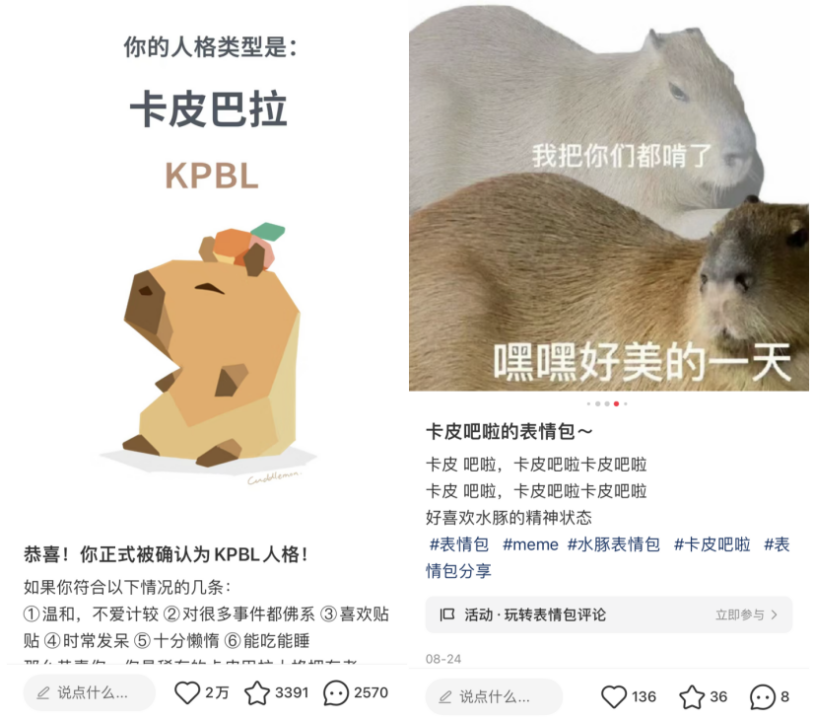
Thus, capybaras have become an emotional outlet for people facing intense competition and self-consumption, using posts or creation of memes to vent stress and heal their hearts. People's orientation to seek emotional support from common pets has moved further, reaching the broader animal world.
A new tea drink brand also spotted this trend, and on October 16th, Heytea announced a collaboration with Hongshan Zoo, featuring two animals from the zoo, the capybara "Almond" and the star white-faced saki monkey "Dudu," on their products, perfectly integrating them into limited-edition stickers and cup sleeves. These two cup sleeves were only available in Jiangsu region, and friends from other areas expressed their envy online after the event launched, with many netizens indicating that they were purchasing entirely for the giveaways.
This campaign sparked a heated discussion on the internet, with related topics on social media garnering over 880,000 interactions in just the month of October.
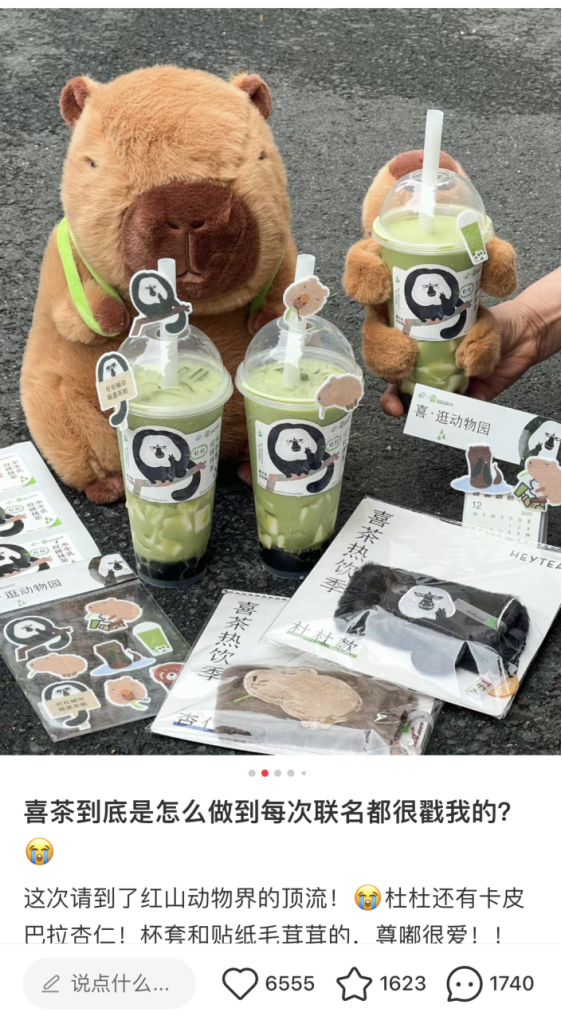
Notably, Heytea also officially announced the adoption of the capybara "Almond" from Hongshan Zoo during this event.
As "the most humane zoo in China", Nanjing Hongshan Zoo has become the object of pursuit by major brands this year, with a total of 14.659 million interactions on mainstream social media from January to October 2023, an increase of 277.5% compared to the previous period. Various brand collaboration events rely on the cute images of small animals to win consumer favor and bridge the gap, as well as to tap into the popularity of Hongshan Zoo to break out of their usual circles.
On a deeper level, adopting animals and protecting them serves as an effective way for brands to tell their ESG stories.
ESG is a topic no influential brand can avoid in recent years, but this concept is too vast, so how to make a big impact from a small entry point has become a technique to master. Previously, Hema and Otterton each adopted a hippopotamus and otter "Banna" from Hongshan Zoo, followed by Chabaida, Dabao, and Midea announcing the adoption of pandas. Brands start with small, familiar, and perceptible animals, allowing people to more directly feel the brand's awareness of animal protection and thus establish a public welfare image of a brand caring for the environment and having social responsibility.
Whether leveraging a national pet like the cat or a virtual pet IP, or by collaborating with breakout star animals, more and more brands are realizing the potent force of the "pet economy" in marketing.
Small animals can provide tangible emotional value and also serve as symbols of consensus. In today's context of emotional overload, they can quickly close the distance between brands and consumers, establish emotional resonance, and provide warmth and healing power. Marketing based on these cute images, to some extent, forms a bridge that consumers and brands run toward each other, allowing companies to subtly complete brand communication.